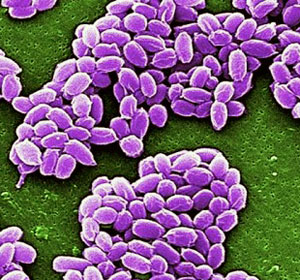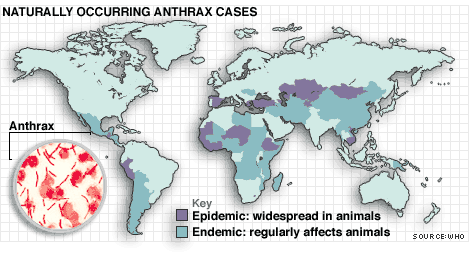Risk factors
To contract anthrax, you must come in direct contact with anthrax spores. This is more likely if you:
- Are in the military and deployed to an area with a high risk of exposure to anthrax
- Work with anthrax in a laboratory setting
- Handle animal skins, furs or wool from areas with a high incidence of anthrax
- Work in veterinary medicine, especially if you deal with livestock
- Handle or dress game animals - in the United States, seasonal outbreaks of anthrax are common among livestock and game animals, such as deer
- Inject illegal drugs, such as heroin
Transmission
Symptoms
There are four common routes of anthrax infection, each with different signs and symptoms. In most cases, symptoms develop within seven days of exposure to the bacteria. The one exception is inhalation anthrax, which may take weeks after exposure before symptoms appear.
Cutaneous anthrax, which affects the skin.
A cutaneous anthrax infection enters your body through a cut or other sore on your skin. It's by far the most common route the disease takes. It's also the mildest - with appropriate treatment, cutaneous anthrax is seldom fatal. Signs and symptoms of cutaneous anthrax include:
- A raised, itchy bump resembling an insect bite that quickly develops into a painless sore with a black center
- Swelling in the sore and nearby lymph glands
Gastrointestinal anthrax, which affects the digestive system.
This form of anthrax infection begins by eating undercooked meat from an infected animal. Signs and symptoms include:
- Nausea
- Vomiting
- Abdominal pain
- Headache
- Loss of appetite
- Fever
- Severe, bloody diarrhea in the later stages of the disease
- Sore throat and difficulty swallowing
- Swollen neck
Inhalation (pulmonary) anthrax, which affects the lungs.
Inhalation anthrax develops when you breathe in anthrax spores. It's the most deadly way to contract the disease, and even with treatment it is often fatal. Initial signs and symptoms of inhalation anthrax include:
- Flu-like symptoms, such as sore throat, mild fever, fatigue and muscle aches, which may last a few hours or days
- Mild chest discomfort
- Shortness of breath
- Nausea
- Coughing up blood
- Painful swallowing
As the disease progresses, you may experience:
- High fever
- Trouble breathing
- Shock
- Meningitis - a potentially life-threatening inflammation of the brain and spinal cord.
Injection anthrax
This is the most recently identified route of anthrax infection. It's contracted through injecting illegal drugs and has been reported only in Europe so far. Initial signs and symptoms of injection anthrax include:
- Redness at the area of injection (without an area that changes to black)
- Significant swelling
As the disease progresses, you may experience:
- Shock
- Multiple organ failure
- Meningitis - a potentially life-threatening inflammation of the brain and spinal cord.
Complications
When anthrax spores get inside the body, they can be "activated." When they become active, the bacteria can multiply, spread out in the body, produce toxins (poisons), and cause severe illness.
The most serious complication of anthrax is inflammation of the membranes and fluid covering the brain and spinal cord, leading to massive bleeding (hemorrhagic meningitis) and death.
Treatments
The standard treatment for anthrax is a 60-day course of an antibiotic, such as ciprofloxacin (Cipro) or doxycycline (Monodox, Vibramycin, others). Which single antibiotic or combination of antibiotics will be most effective for you depends on how you were infected with anthrax, your age, your overall health and other factors. Treatment is most effective when started as soon as possible.
Although some cases of anthrax respond to antibiotics, advanced inhalation anthrax may not. By the later stages of the disease, the bacteria have often produced more toxins than drugs can eliminate.
Antitoxin therapies have been developed. Instead of going after the bacteria that causes the disease, these medications help eliminate the toxins caused by the infection. These medications are still considered experimental.
Vaccination
An anthrax vaccine for humans is available. The vaccine isn't intended for the general public. Instead, it's reserved for military personnel, scientists working with anthrax and people in other high-risk professions.


